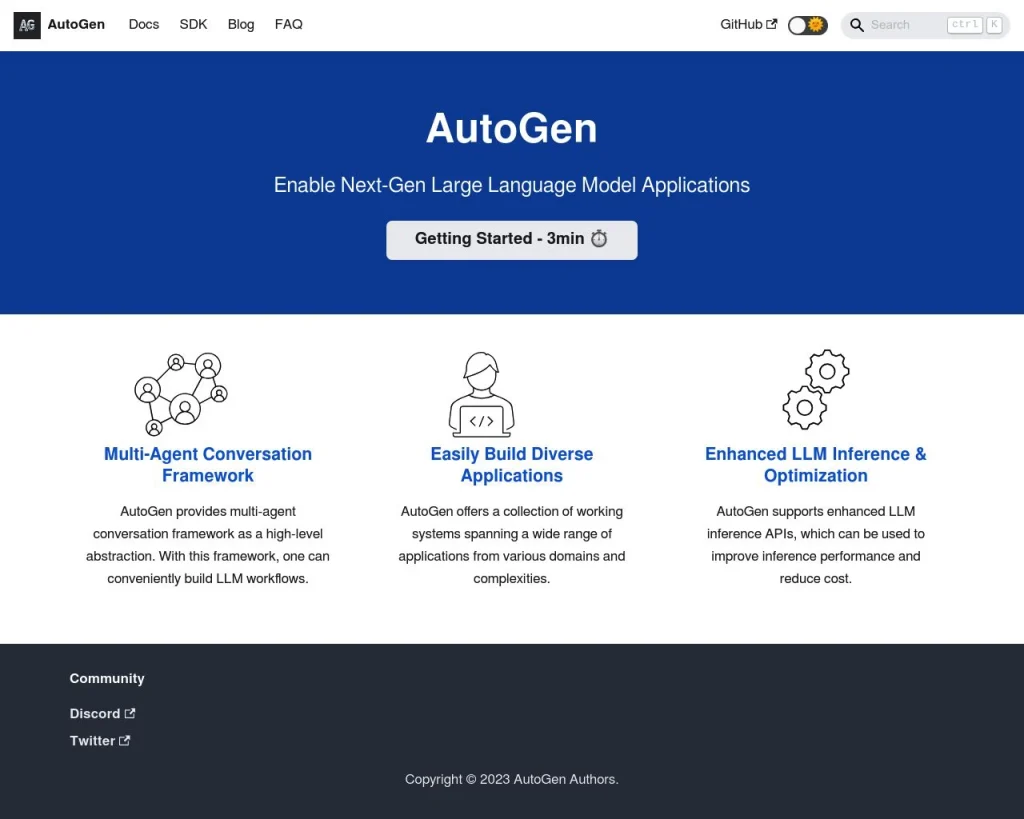Overview of Langchain and Autogen

In the realm of Artificial Intelligence (AI), two powerful tools are shaping the way you build and deploy AI-driven applications. Langchain and Autogen offer unique advantages for developers and startups keen on integrating advanced natural language processing (NLP) into their solutions.
Langchain: Customizable AI Systems
Langchain is an AI platform designed to serve developers and engineers who want to integrate OpenAI’s GPT-4 and other large language models (LLMs) into their projects. Its key strength lies in customization, providing a suite of tools that enable you to tailor LLM applications according to your specific requirements. Its flexibility makes it highly suitable for a variety of projects, from startups to more established businesses.
- Key Attributes of Langchain:
- Customizable pipelines for LLM integration
- Emphasis on developer control and flexibility
Langchain’s code-centric approach allows software developers and data scientists to build applications that can harness the full potential of LLMs, especially in areas that require a sophisticated understanding of language.
Autogen: Automating Generative AI

On the other hand, Autogen is focused on simplifying the generation of code through AI. If you’re a project manager or engineer with the need to speed up development cycles, Autogen might be just what you’re looking for. It automates repetitive coding tasks, essentially augmenting your capabilities and letting you focus on more complex aspects of your development work.
- Key Attributes of Autogen:
- Streamlines code generation
- Targets faster development turnaround
The vision for Autogen is to make the lives of developers easier by offering a tool that quickly translates ideas into functional code, leveraging the power of generative AI to expedite software development.
In using both these tools, you’re tapping into powerful AI advantages—Langchain’s deep customization for NLP tasks and Autogen’s automation of code generation—to take your projects to the next level.
Technical Capabilities and Integration
Exploring the technical capabilities and integration of LangChain and AutoGen reveals their potential to revolutionize language model applications and data analysis.
Adaptable Language Model Applications
You’ll find that with LangChain, developers have access to a highly customizable framework to build NLP applications. It’s designed with the flexibility to integrate external data sources and apply various language model (LLM) applications. Here’s a sneak peek at how you can leverage LangChain in Python:
from langchain.llms import OpenAI
llm = OpenAI(api_key='your-api-key')
response = llm('Generate a summary of the latest tech news.')
In contrast, AutoGen specializes in creating customizable agents with enhanced memory & context abilities, which is crucial for task-specific problem-solving capabilities. With AutoGen, you’d use it like this:
const autogen = require('autogen-sdk')('your-api-key');
autogen.createAgent({
name: 'YourAgent',
task: 'Summarize tech news',
context: 'keep a note of user preferences',
});
Seamless Data Analysis and External Integrations
When it comes to data analysis, both tools shine with their ability to seamlessly analyze data from various sources. For instance, AutoGen and LangChain include composable tools that can be integrated with JavaScript or TypeScript applications to enhance user interactivity. They provide robust APIs for developers wanting to build or extend their own user interface.
Here’s how easily you can integrate external APIs with LangChain:
from langchain.external import ExternalAPI
my_api = ExternalAPI('https://your-external-api.com/data')
llm = OpenAI(api_key='your-api-key')
response = llm(f"Analyze this data: {my_api.get()}")
Regarding hosted agents, both LangChain and AutoGen let you deploy agents that interact with users, maintain memory & context, and offer continuous learning and adaptation. This integration is instrumental for developing LLM applications that go beyond typical chatbots to more advanced problem-solving utilities.
Incorporating these tools into your workflow can be as straightforward as:
- Using APIs to connect with external data sources.
- Implementing Python or JavaScript/TypeScript to script customizable agents.
- Utilizing hosted solutions for memory & context in conversational agents.
Remember, leveraging these technical capabilities effectively can help you build tools that not only understand language but also engage meaningfully with the real-world data and tasks at hand.
Interactivity and User Experience

When you’re deciding between LangChain and AutoGen, it’s crucial to consider how they each handle the challenge of interactivity and user experience. Each platform has unique features designed to engage both developers and end-users in different ways.
Enhancing Communication with Multiple Agents
LangChain facilitates your interaction with multiple AI agents in a seamless manner. Suppose you’re orchestrating a conversation between various generative AI systems including GPT-3.5 and systems based on MetaGPT or BabyAGI. In that case, LangChain’s modular design comes in handy, allowing for efficient communication across different modules.
- Multi-Agent Conversations: LangChain specializes in creating an ecosystem where you can have different AI agents, like generative AI and large language models (LLM), communicate effectively.
# LangChain example for multi-agent communication from langchain.agents import GPTAgent, BabyAGIAgent gpt_agent = GPTAgent(...) babyagi_agent = BabyAGIAgent(...) # Orchestrate a conversation between agents conversation = langchain.orchestrate(gpt_agent, babyagi_agent)
User-Centered Tools and Debugging
AutoGen, on the other hand, emphasizes user-centered tools such as a no-code editor and visual builder which make it highly adaptable to your needs. You can drag and drop components in a multimodal interface, simplifying the development process without ever writing a line of code.
- Visual Tools & Debug Mode: AutoGen supports developers with features like a visual builder that helps in creating workflows, and debug mode for efficient error handling and debugging.
// AutoGen visual builder (pseudo-code) AutoGen.visualBuilder() .addCondition(...) .addAction(...) .build();
Transparency and Decision-Making Support
Both platforms offer varying degrees of transparency and decision-making support by providing tools that explain how decisions are made by the AI. LangChain scores with its in-depth audience analysis, helping you understand the AI’s decision-making process and how it aligns with your audience’s needs.
- Explainability & Debugging: LangChain’s explainability features give insights into an AI’s decision-making.
- Autonomous Operations & Human Interaction: AutoGen balances autonomy with the need for human interaction, providing a user experience that supports both autonomous operations and decision-making with explainable AI insights.
| Feature | LangChain | AutoGen |
|---|---|---|
| Debugging | Advanced debugging with clarity | Simple debug tools, more suitable for non-developers |
| Decision Support | Detailed decision trees for better explainability | Generative AI with explainability for autonomous choices |
| Multi-Agent Support | Robust orchestration for AI agents | Primarily focused on generative AI applications |
By weighing the capabilities of how each system supports interaction, transparency, and decision-making, you’ll be better equipped to choose the one that aligns with your project’s needs.
Frequently Asked Questions
Let’s dig into some of the common questions you might have about AutoGen and LangChain.
What are the main differences between AutoGen and LangChain?
AutoGen focuses on automation with unique features, whereas LangChain is designed as a platform for developers to create LLM-based agents.
Which tool, AutoGen or LangChain, performs better for natural language processing tasks?
Performance can vary based on the task, but LangChain is often lauded for its ability to create LLM-based agents, which can be crucial for complex NLP tasks.
Which companies are the top rivals of Microsoft’s LangChain in the AI field?
Companies offering multi-agents like AutoGen are considered top rivals to LangChain, along with others like XAgent, MetaGPT, and BabyAGI.
Can you give a brief overview of what Microsoft AutoGen does?
Microsoft AutoGen automates tasks by leveraging AI, making it easier for you to integrate smart features into applications.
How does the AutoGen agent function, and what are its primary uses?
AutoGen agents work by processing data and executing tasks based on predefined logic, primarily used in scenarios requiring automation and AI-assisted decisions.
In terms of integration and user-friendliness, how do AutoGen and LangChain compare?
AutoGen may offer better automation out-of-the-box for user-friendly applications, while LangChain requires more developer involvement but provides a robust platform for creating intricate LLM-based applications.

